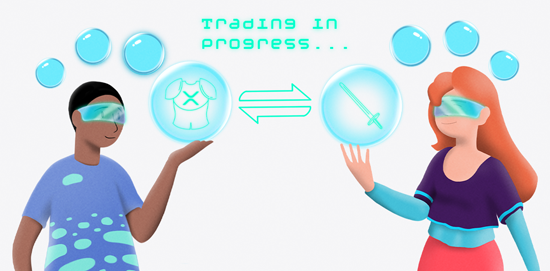Lesson 9
Trending topics: Gaming
Digital assets for digital worlds

It’s no secret that the gaming industry is a massive global market, worth an estimated $300 billion in 2022. But what you may not know is that blockchain and cryptography are changing the game—no pun intended.
Blockchain enables a new level of transparency, trust, and decentralization in the gaming industry. And that’s just the beginning. Below are three ways blockchain and crypto are changing the world of gaming.

Play-to-earn
Let’s say you’re a gamer and you’re pretty good at it. Wouldn’t it be great to earn some money just by playing the games you love? With blockchain, that’s now possible.
This is known as “play-to-earn,”, and it’s a model that’s being adopted by more and more gaming platforms. In a play-to-earn game, players can earn in-game tokens for completing tasks and goals.
These tokens can then be used to buy in-game items, traded with other players, or even exchanged for other cryptocurrencies. This offers gamers a financial incentive to keep playing and progressing in the game.
In-game assets (NFTs)
In the past, when you bought a digital item in a game—like a sword or a piece of armor—you didn’t actually own it. The item existed only in the game itself and you couldn’t take it with you or sell it to someone else.
Now, in-game assets can be stored on the blockchain as non fungible token (NFTs). This means that they are unique, immutable, and can be traded or sold just like any other asset.
Creator economy
Traditionally, the gaming industry has been dominated by a few large companies. But with blockchain, power is shifting to the creators—the people who actually invest their time and energy into making games.
Using blockchain, game developers can create their own in-game currencies, raise funds through crowdfunding, and build entire economies around their games. This allows them to retain full ownership and build a strong community.
It also creates a more level playing field, making it easier for small developers to compete with the big names in the industry.
Let’s take a look at some of the games and platforms that are leading the charge in this new world of gaming:
Axie Infinity
Axie Infinity sees players breeding, battling, and collecting fantasy creatures called Axies. As NFTs, these Axies can be traded, sold, or bred with other Axies to create new generations of creatures.
Players can also earn SLP tokens—the native currency of Axie Infinity—for completing in-game tasks. These tokens can be used to buy in-game items or exchanged for other cryptocurrencies.
Forte
Forte is a blockchain platform that provides funding and infrastructure for game developers. The platform offers a number of services, including in-game currency creation, crowdfunding, and payment processing.
So whether you have an idea or you’re already deep in development, Forte can help you bring your game to life and help you tap into the growing world of blockchain gaming.
CryptoKitties
CryptoKitties is one of the first and most popular blockchain games. As we mentioned in the previous lesson on NFTs, you could argue that it triggered the NFT craze.
In CryptoKitties, players can breed, collect, and trade digital cats. These cats are stored as NFTs on the Ethereum blockchain, meaning they can be bought, sold, or traded just like any other asset.
